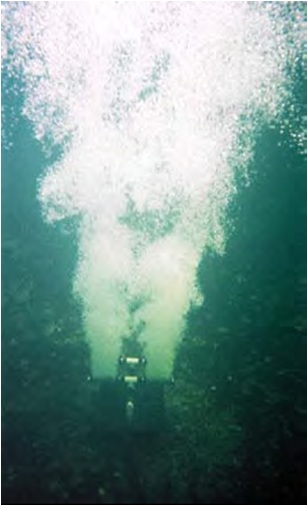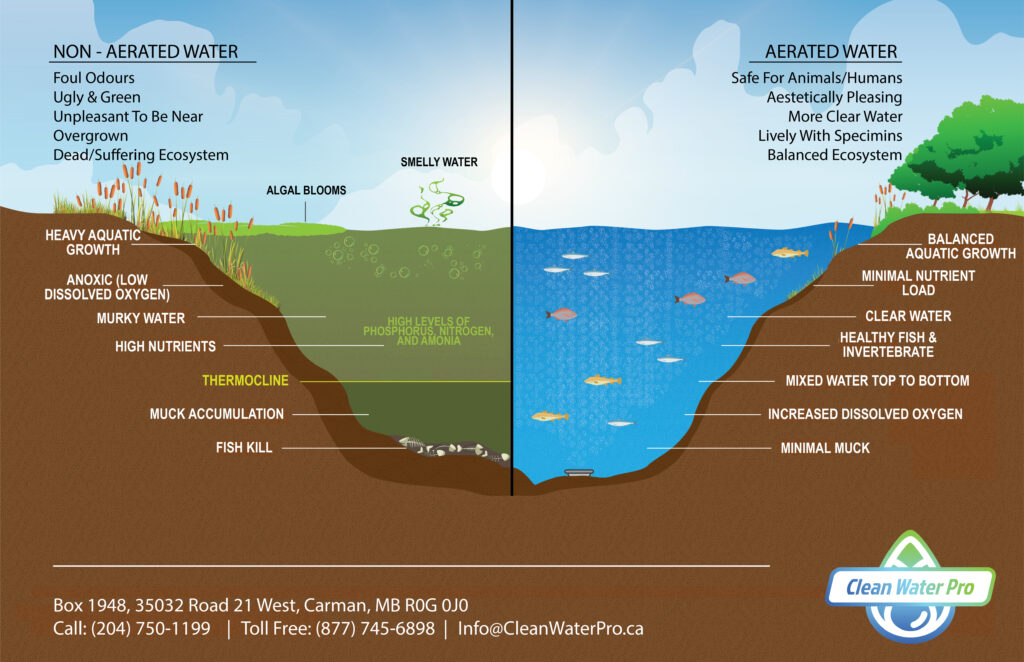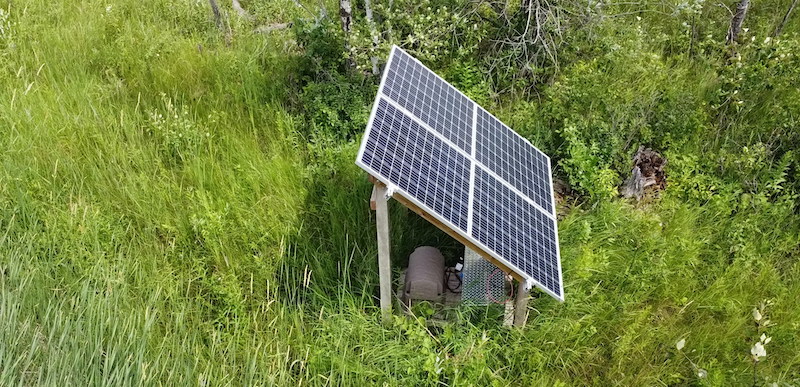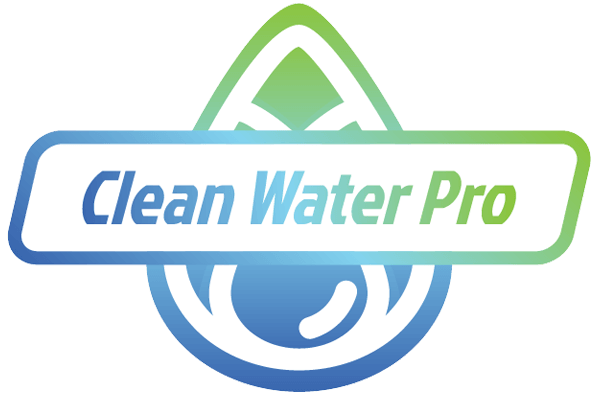Water Aeration: What Is It?

Water aeration refers to the process of introducing air or oxygen into water. It involves the agitation or mixing of water to enhance the exchange of gases, particularly oxygen and carbon dioxide, between the water and the surrounding air. Aeration is used in ponds, lakes, rivers, and even wastewater treatment plants to improve water quality.
The primary purpose of water aeration is to increase the dissolved oxygen content in the water. Dissolved oxygen is essential for the survival of aquatic organisms, including fish, plants, and beneficial bacteria. Adequate oxygen levels support the biological processes necessary for a balanced and thriving ecosystem. Aeration also facilitates the removal of harmful gases, such as carbon dioxide and methane. Carbon dioxide and methane accumulate in stagnant or poorly oxygenated water.
Benefits of Water Aeration Include:
Enhanced Oxygen Levels: Aeration boosts the dissolved oxygen concentration in water. Increased dissolved oxygen levels ensure that aquatic organisms have access to an adequate supply for respiration. This is crucial for the health and growth of fish and other aquatic life.
Mitigation of Algae Growth: Proper aeration can help prevent excessive algae growth by disrupting the conditions that favour algal blooms. Algae growth can lead to oxygen depletion and water quality degradation.
Nutrient Circulation: Aeration promotes the mixing of nutrients throughout the water column, preventing stratification and reducing the accumulation of nutrients at the bottom. This can help manage nutrient pollution and eutrophication.
Waste Decomposition: Aeration supports the activity of aerobic bacteria, which play a vital role in breaking down organic matter and waste. This decomposition helps maintain water clarity and prevents the accumulation of harmful byproducts.
Temperature Regulation: Aeration can moderate water temperature by facilitating heat exchange between the water and the air. This can be especially beneficial in preventing temperature extremes that can stress aquatic organisms.
Ammonia Removal: Aeration aids in converting harmful ammonia compounds into less toxic forms through nitrification, a microbial process that benefits aquatic life.
Water Movement and Circulation: Aeration systems create water movement and circulation, which can deter the formation of stagnant areas, reduce sediment buildup, and support overall water health.
Wastewater Treatment: Aeration facilitates the biological treatment of wastewater, where microorganisms break down organic pollutants before the treated water is discharged.
Water aeration plays a vital role in maintaining aquatic systems’ ecological balance and health. By enhancing oxygen levels, promoting nutrient circulation, and facilitating biological processes, aeration contributes to clearer, healthier water that supports diverse aquatic life and sustainable ecosystems.

Methods of Water Aeration
Water aeration is most effective when oxygen-rich air is supplied directly to the bottom of your lake or retention pond. By doing so, the air is applied directly to the oxygen-loving bacteria that thrive on consuming the sediment at the bottom of the lake or pond. In stagnant water bodies, a thermocline develops towards the bottom.
The water below the thermocline is colder and anoxic compared to the water above it. Applying oxygen to the pond’s bottom removes the thermocline and activates the desired bacteria. Simultaneously, this process eliminates anaerobic organisms in the lake that produce harmful substances like blue-green algae.
1. Fine Bubble Water Aeration
The most efficient method of water aeration is fine-bubble systems, as smaller bubbles lead to higher oxygen transfer. Fine bubble diffusers designed to draw water from the pond or lake’s bottom are ideal.
Anoxic water from the bottom is brought to the surface, and as the bubbles interact within the water column and emerge at the surface, dissolved oxygen enters the water. This oxygen-rich water is circulated throughout the water column, effectively mixing the water from top to bottom and activating the aerobic bacteria at the pond or lake’s base.
This process results in healthier, clearer water with abundant oxygen for fish and other aquatic organisms.

2. Solar Aeration
When it comes to solar aeration systems, not all are created equal. Many solar aeration systems available today rely on 24-volt compressors and limit their operation to the sunlit hours.
While any form of aeration is undoubtedly better than none, the question arises: is this “daylight-only” approach with relatively low CFM (cubic feet per minute) really the optimal solution for all ponds?
Ponds, like any living ecosystem, don’t take a break when the sun goes down. If you’re nurturing delicate aquatic life in your pond, such as Trout, the conventional 24-volt compressor aeration system may not be your best bet.
Let us introduce you to a more fitting alternative: the rocking piston 110V or 220V system, accompanied by a custom solar panel and trusty batteries.
Picture this – a system meticulously designed to provide up to 20 hours of aeration during the balmy summer months. Sounds like a breath of fresh air for your pond, doesn’t it?
If you plan on overwintering fish, ensure the solar system runs 24/7, even during December and January. Imagine it humming along 24/7, even through the chilly December nights and frosty January mornings.
So, as we dive deeper into the world of solar aeration, remember that not all systems are born equal. When it comes to your pond’s health and the well-being of its inhabitants, choosing wisely can make all the difference.

3. Coarse Bubble Water Aeration
Coarse bubble systems were popular in the past when aeration was a novel concept. However, technological advancements have significantly increased efficiency. Coarse bubble aeration involves large air bubbles pushed into the water.
While it effectively keeps the water surface open, it doesn’t significantly increase dissolved oxygen levels. Additionally, these systems are costly to install and maintain.
Coarse bubble aeration has yielded ground to more contemporary methodologies that offer superior oxygenation efficiency and cost-effectiveness.
4. Windmill Water Aeration
While windmills might seem appealing in theory due to their lack of hydroelectricity requirements, solar systems provide a more reliable solution. Windmills operate only when there’s wind, which can be an issue during calm summer nights.
Windmill durability is often limited, requiring frequent repairs. If you choose to install a windmill, it’s advisable to select one with a robust warranty.
In Summary
Understanding and implementing effective water aeration strategies can play a vital role in maintaining the health and quality of your aquatic ecosystem. By supplying oxygen-rich air directly to the bottom of lakes or retention ponds, you can promote the growth of beneficial bacteria that contribute to a cleaner environment. The choice of the aeration system is crucial, with fine bubble aeration standing out as a highly efficient option, maximizing oxygen transfer and ensuring a well-mixed water column that benefits aquatic life.
Solar aeration presents a sustainable alternative, but carefully considering system specifications is essential to ensure consistent operation, particularly during nighttime and cold weather. On the other hand, coarse bubble systems, while historically significant, have been outpaced by technological advancements that offer greater efficiency and cost-effectiveness.
While windmill aeration may hold theoretical appeal, its intermittent operation and potential maintenance challenges make it less reliable than modern alternatives, such as solar-powered systems with robust warranties.
By making informed decisions about aeration methods and system design, you can contribute to the long-term well-being of your water bodies and enjoy the benefits of clearer, healthier, and more vibrant ecosystems.
Do you need help choosing an aeration system for your water body? Our team at Clean Water Pro designs, installs, and maintains aeration systems for commercial and residential water bodies. Contact us today! You can also browse our water aeration systems at PondSupply.ca!
